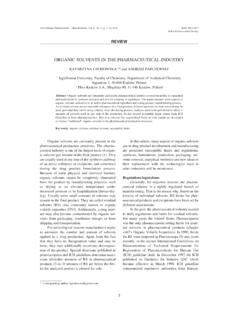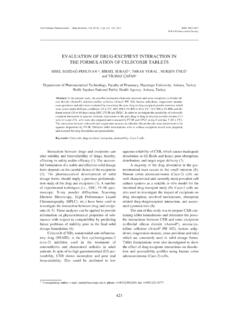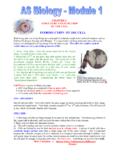Transcription of PLANT STEM CELLS AS INNOVATION IN COSMETICS
1 Acta Poloniae Pharmaceutica Drug Research, Vol. 71 No. 5 pp. 701 707, 2014 ISSN 0001-6837 Polish Pharmaceutical SocietyAt the turn of XX and XXI centuries, one ofthe promising research directions in natural sciencesbecame a regenerative medicine. Researches relat-ing to the different multi-cell organisms abilities inregeneration of damaged organs or even body frag-ments are carried for years. In some animals, theregeneration processes are intensive and large bodyfragments may be regenerated (coelenterates, pla-narians, amphibia), while in others the regenerationprocesses may be limited only to regeneration ofdamaged tissue or organs ( , human being). Inhuman being, together with the ageing process,which starts about the age of 25 years (chrono-age-ing), increases the number of CELLS in tissues andorgans that are subject to a degeneration, and theirregeneration processes together with the age subjectto slow-down.
2 The stem CELLS are responsible forregeneration of damaged or wearing-out tissues ororgans in human being and in other multi-cell ani-mals (1, 2).The organ, in which the ageing changes arebest visible, is the skin inside which, together withthe age the numerous superficial and then deepmimic wrinkles as well as teleangiectasies andmelanosis appear. These changes occur both on theepidermal, dermal and subcutaneous tissue , also the human skin must contain cellsresponsible for its regeneration (3).Characteristics of stem cellsThe stem CELLS are the ones able to potential-ly unlimited number of mitotic divisions and alsodifferentiation to a specific CELLS . The stem celldivision results in appearance the so called pro-genitor CELLS , , the partially differentiated CELLS ,which after sequent division shall become the dif-ferentiated CELLS only or they may be subjected todirect differentiation without any further cell divi-sion.
3 Depending on what CELLS appear in result ofthe stem cell division, and namely if the division isREVIEWPLANT STEM CELLS AS INNOVATION IN COSMETICSMARTYNA MORU 1, MONIKA BARAN1, MAGDALENA ROST-ROSZKOWSKA1,2* and URSZULA SKOTNICKA-GRACA1,31 Silesian Medical College in Katowice, Mickiewicza 29, 40-085 Katowice, Poland2 University of Silesia, Department of Animal Histology & Embryology, Bankowa 9, 40-007 Katowice, Poland 3 Silesian Medical University, General Surgery & Multi-organ Trauma Chair, Surgery Nursery DepartmentAbstract: The stem CELLS thanks to their ability of unlimited division number or transformation into differentcell types creating organs, are responsible for regeneration processes. Depending on the organism in which thestem CELLS exists, they divide to the PLANT or animal ones. The later group includes the stem CELLS existing in bothembryo s and adult human s organs.
4 It includes, among others, epidermal stem CELLS , located in the hair folli-cle relieves and also in its basal layers, and responsible for permanent regeneration of the epidermis. Temporaryscience looks for method suitable for stimulation of the epidermis stem CELLS , amongst the other by delivery , growth factors for proliferation that decrease with the age. One of the methods is the use of the PLANT cellculture technology, including a number of methods that should ensure growth of PLANT CELLS , issues or organs inthe environment with the microorganism-free medium. It uses abilities of the different PLANT CELLS to dediffer-entiation into stem CELLS and coming back to the pluripotent status. The extracts obtained this way from the plantstem CELLS are currently used for production of both common or professional care COSMETICS . This workdescribes exactly impact of the PLANT stem cell extract, coming from one type of the common apple tree(Uttwiler Sp tlauber) to human skin as one of the first PLANT sorts, which are used in cosmetology and :stem CELLS , PLANT stem CELLS , pluripotency, Malus domestica, Uttwiler Sp tlauber, PLANT tissue culture701* Corresponding author: e-mail: phone: 603-708-098, fax: 32-2072005702 MARTYNA MORU et or asymmetric, the role of the givendivision is defined.
5 If the stem cell is divided sym-metrically, and two descendant stem CELLS appear,then such division is aimed for enlarging the stemcells pool. If the asymmetric division results inappearance of two descendant stem CELLS that dif-fer: the stem cell and the progenitor cell, then suchdivision is aimed for creation of the line of cellsthat differ, with simultaneous maintenance of thestem cell line. It s also possible a symmetric stemcell division that however leads to appearing oftwo progenitor CELLS . Thus, such division shallresult in increasing of the differentiating cellspool, without simultaneous reproduction of thestem line (1).As mentioned above, the stem or progenitorcells may differentiate into specific CELLS that form agiven tissue or organ. There are also different abili-ties of the stem CELLS differentiation (so called poten-tial): from unlimited to limited.
6 Therefore, the stemcells may be divided to (1):a. Totipotential CELLS that may differentiate into anyorgan cell, and also in case of human being intothe extra-embryonic structure CELLS such as fetalmembranes. In human being, the totipotentialcharacter have the early embryo CELLS only, wherethere s no separated embryoblast and Pluripotential CELLS are able to differentiate intothe body building structures only, and they cancreate no extra-embryonic structures such as fetalmembranes. In human being, the pluripotentialcharacter have, among others, the embryoniccells on the blastocyst stage, and exactly theembryoblast cell in the blastocyst. Thus, thepluripotential CELLS may differentiate into cellsfrom all the three embryo germ layers: ecto-,endo- or Multipotential CELLS may differentiate into cellscoming, within the embryonic growth, from onegerm layer only, thus, from the ecto-, endo- ormesoderm only.
7 D. Unipotential CELLS , in turn, are the ones withstrongly limited differentiation abilities, thus,differentiating into one particular cell type. Theunipotential CELLS exist in the adult human organs, , in liver, where they are responsible for thegiven organ regeneration other division criterion is the organismtype, from which the cell originates. Thus, we candiscern the PLANT or animal stem CELLS . The latterinclude the stem CELLS existing both in the adulthuman or embryo organisms. Stem CELLS of epidermisThe epidermis, being the external body coat-ing, is directly exposed to numerous external envi-ronment factors ( , mechanical traumas, tempera-ture, pathogenic microorganisms, xenobiotics, UVradiation) that affect the homeostasis disorder notonly of the skin, but also the entire , mechanisms must be created enablingcreation of the barrier against factors the action ofwhich shall also speed-up the ageing process.
8 One ofsuch mechanisms is the keratinization process, ,keratosis of the epidermis external layers. The epi-dermis keratinocytes come from its basal layerthrough the prickle and granular layer (possibly alsothrough the light layer) to the horny layer, insidewhich due to numerous changes they start to per-form into korneocytes. Thus, keratinization means aseries of biochemical and morphological changes,being the programmable processes that lead amongothers, to the cell proliferation ability loss, degener-ation of the cell organelle parts ( , cell nucleusfragmentation and breakdown, partial breakdown ofthe endoplasmic reticulum cisterns) and appearingof the new ones ( , lamellar bodies, keratohyalinegranules), changes in the cell membrane chemicalcompositions and also appearing of numerous pro-teins ( , involucrine, filagrine binding proteins)and lipids (sterols or phospholipids being theceramides precursors) (4 6).
9 Researches show thatthe epidermis granular layer keratinocytes degener-ate by apoptosis (3, 7), while the corneocytes locat-ed on the horny layer, are subjected to peeling underaction of proteolytic enzymes that degrade the cor-neodesmosomes, , specialized inter-cellular linkspresent in the epidermis horny layer. The ceramides,being the main inter-cellular cement component, arealso subjected to changes: degradation to sphingo-sine and fat acids, which results in the intercellularcement liquefaction (4). Consequently, the corneo-cytes are mechanically removed from the epidermis regeneration process is possiblethanks to the presence of his stem CELLS in it. Theirlarger conglomeration is the hair follicle bulge,called the bulge area (3, 8). In this place, such cellsintensively divide enlarging its pool, and then theymigrate.
10 Part of them migrates to the hair germinalmatrix (where they participate in the hair appearingand growth), while the others go to the apical hairpart, in order to home the epidermis basal the migration to the epidermis, the stem cellsmeet the area located just over the sebaceous gland,where there are concentrated stem CELLS responsiblefor production of sebum (8). PLANT stem CELLS as INNOVATION in cosmetics703 However, in order to enable the keratinizationand epidermis regeneration process creating theprotective layer for the entire organism, many fac-tors must be controlled. Besides the many vitamins,calcium ions, or water level, attention should bepaid to a keratinization control process by the ker-atinocytes themselves. They synthesize and emitmany factors that control their process of prolifera-tion and differentiation.
















